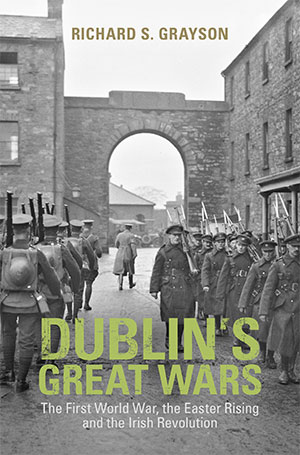Dublin’s great wars: the First World War, the Easter Rising and the Irish Revolution
Published in Book Reviews, Book Reviews, Issue 6 (November/December 2018), Reviews, Volume 26RICHARD GRAYSON
Cambridge University Press
£20
ISBN 9781107029255
Reviewed by John Gibney
 John Gibney is DFAT100 Project Co-ordinator with the Royal Irish Academy’s Documents on Irish Foreign Policy project.
John Gibney is DFAT100 Project Co-ordinator with the Royal Irish Academy’s Documents on Irish Foreign Policy project.
Richard Grayson’s Dublin’s great wars is an exploration of how Dubliners (from both city and county) participated in conflict during the revolutionary era. That means, in essence, that it is primarily about those who fought in the First World War, the Easter Rising, the War of Independence and the Civil War.
One of the principal assumptions of both of the commemorations (official and otherwise) that make up the ‘Decade of Centenaries’ relates to the concept of a ‘shared’ history. This notion is usually applied to the study of the Irish involvement in the First World War, which in terms of participation and human cost far outstripped the independence movement. There is a bigger issue here, however, as the Irish role in the Great War is very deliberately used to introduce an element of complexity (and, indeed, reconciliatory gestures) into the history of the period. That said, the exploration of the Irish role in the war and the better-known narrative of the independence movement that forms the spine, one might say, of the ‘Decade of Centenaries’ are not necessarily studied in an intertwined fashion. Yet the two cannot be divorced from one another if one attempts to study the period in earnest.
Grayson’s book is a significant attempt to do just that, often cutting from one theatre of conflict to another, as he explores events whose main common thread is often the simple fact that they were happening at the same time. The examination of the Irish role in the First World War can often fall into the trap of a particular commemorative trope—that of the individual story of ‘sacrifice’, chosen for the personal (i.e. heroic) qualities of the soldier in question but often divorced from a wider context. Grayson also focuses on the personal, but his narrative (or narratives) locates his diverse subjects more fully within the broader strategies and context of the conduct of the war and of Irish political life. He does so deftly, juggling a vast range of individual stories and testimonies from the First World War, the Easter Rising, the War of Independence and the Civil War, yet never letting them fragment his overall account.
It adds a human dimension to the book. Take, for example, the colourful career of Emmet Dalton, who as a member of the Royal Dublin Fusiliers was present at the death of Tom Kettle during the Battle of the Somme in 1916 and, having subsequently joined the IRA, was present at the death of Michael Collins as a member of the National Army in 1922 (Grayson has much to say on the subject of British Army veterans who subsequently enlisted in the IRA). Likewise, the horrific experience of conflict can be seen in the tragic death of Irish rugby international Jasper Brett, who had fought at Gallipoli and in the Balkans before being hospitalised and diagnosed with a wide range of psychological problems arising from his war experience. Having been discharged from hospital, he committed suicide in January 1917 near Dalkey by lying down in the path of a train.
This is a large but very readable book, written in a clear and lively style and resting upon very substantial research. Grayson has attempted, very usefully, to tabulate that research into broader findings about the social composition of those who fought in the various organisations that he examines. By its nature, Dublin’s great wars does not form an unbroken narrative, which is inevitable (though the structure of the chapters means that the book can be dipped into as required). It is impossible to shoehorn the diverse events and subjects that Grayson explores into a conveniently seamless account, but the readability of the book makes up for this. Many well-known events are present, such as the Somme, Messines and the Easter Rising, all of which are treated comprehensively, but a great strength is its exploration of the Irish involvement in lesser-known theatres of war, such as the Balkans, as well as its treatment of the IRA campaign in Dublin during the War of Independence, elements of which are very well known but which is not always viewed in the round.
More could be said about the impact of the war on Dublin’s ‘home front’, but in fairness that is a subject that looms large in Padraig Yeates’s trilogy on revolutionary Dublin. Grayson deals with the history of those who participated, and his book casts light on topics as diverse as Dublin’s role as a ‘garrison’ town, the vexing subject of commemoration, and the treatment and experience of veterans after their wars were over. Does it put forth a new and radical analysis? No, but sometimes there is no need to. A sensible and effective means of revealing the complexity of the past is simply to explore it and set it down. Dublin’s great wars is an excellent and illuminating account of how conflict shaped Ireland’s capital city during the Irish revolution and is bound to command the wide audience that it deserves.
















